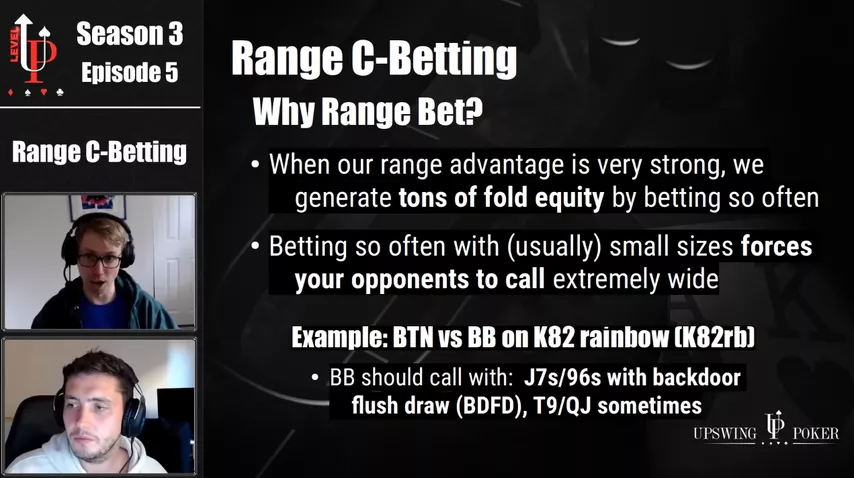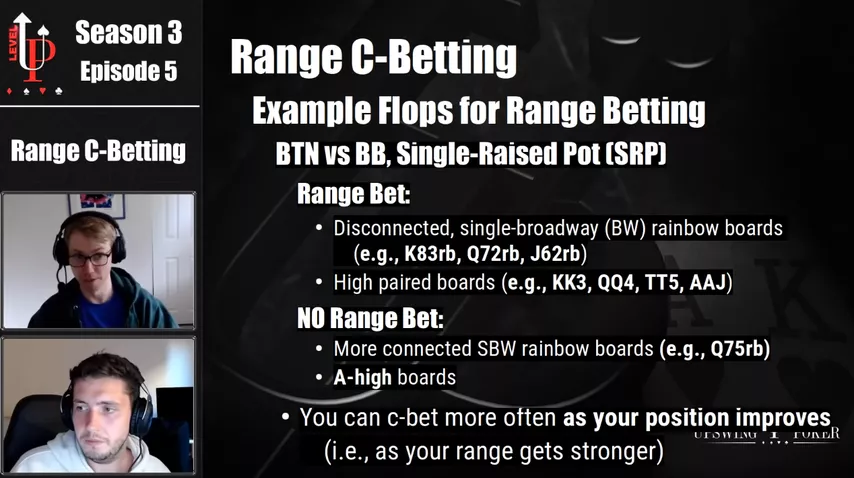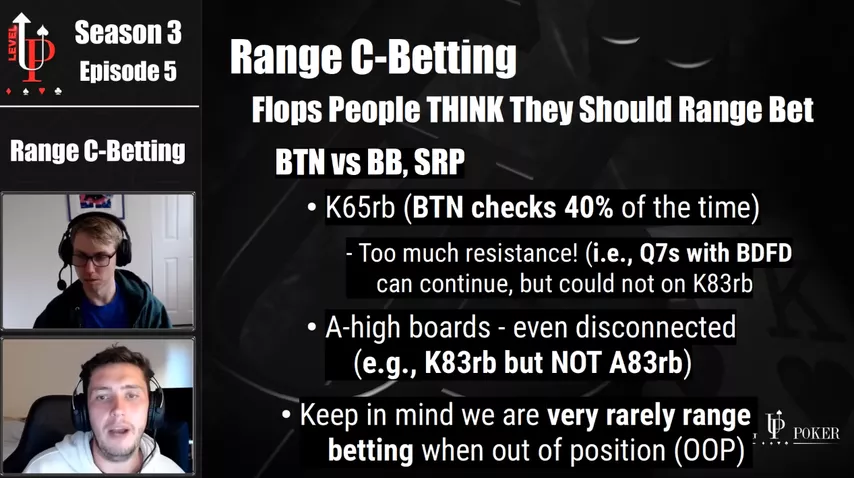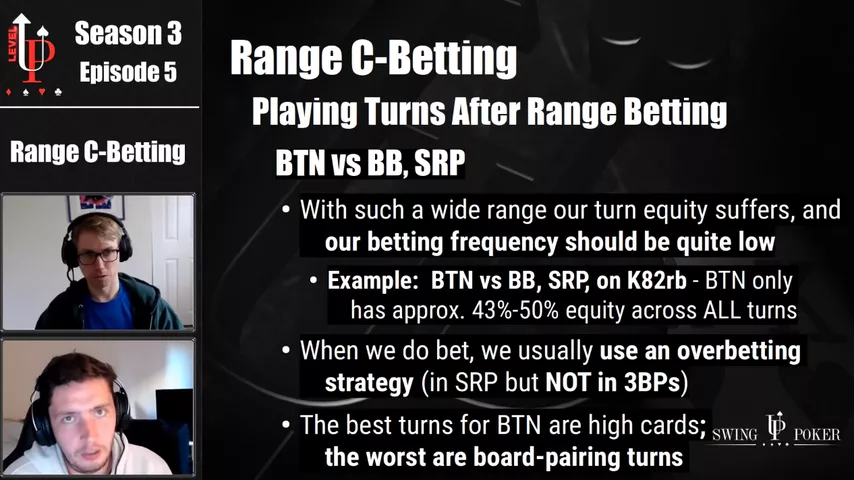Upswing Poker mentors Mike Brady and Gary Blackwood have been hosting the very upbeat Level Up podcast on the school's channel for almost a year now. Both are big fans of GTO, and they explain fundamental poker strategy in a very clear way. One of the latest issues is dedicated to range bets.
— (Mike) Hello everyone! Welcome to the show that helps you quickly start playing stronger. Today we’ll talk about range bets – that is, about situations when it is profitable to bet with the entire range. Skillful use of this strategy is guaranteed to increase your win rates – but the key word here is “skillful”. We will discuss both single-raised pots (SRP) and 3-bet pots. So, Gary! Why bet with the entire range at all?
— (Gary) Hello! Great first question, Mike. In poker, understanding why we do something is much more important than simply memorizing the “right answers.” Range bets imply that we have a very large range advantage. And in this situation, our bet will:
- Generate a lot of fold equity.
- Force our opponent with a small bet (and we will usually bet a little) to pay very widely, often with almost no equity.
Let's say you open from the button, the BB pays, and the flop is . You bet with any hand and force your opponent to sometimes call with complete garbage in order to at least somehow resist your strategy. For example, J7s with a backdoor, 96s with a backdoor, T9o, JQo – not always, of course, he will call with this, but according to GTO he must do this quite often. So, by betting with our entire range, we realize our equity advantage and our opponent ends up with a very questionable range on the turn.

– On the other hand, even if your opponents don't defend all these hands (and they usually won't), then you're just printing money. As a result, the ideal situation is: you either take the pot with a small continuation bet or, if your opponents defend correctly, you go to the turn – and there you still have an advantage in the nuts and position. Dream scenario!
Flops suitable for range bets
— Gary, the button is against the BB, we raise, then call. What flops do we always bet on?
– In fact, there are much fewer such flops than players usually think. These are exclusively unconnected offsuit boards with one broadway card (not an ace – we'll get to that shortly): K83, Q72, J62. The rule here is simple and intuitive: you can bet with the entire range in situations where you receive minimum resistance. For example, the solver bets on Q72o in 90% of cases – to simplify the strategy, we round up to 100% and always bet. But on a Q75o flop, a player with K6s may well want to see the turn. Therefore, the solver bets such a flop only 76% of the time. The difference doesn't look huge, but it's actually quite significant. Also, high paired boards are suitable for rangebet with small sizing: KK3, QQ4, TT5, AAJ.
If you raised from the UTG (under the gun) and not from the button, then you can bet with your entire range more often. The logic here is simple: from the button, you open 45% of hands, from MP – 22%, from UTG – 17%. So the range becomes much stronger, and you will have much less empty hands on the flop.

3bet pots (button vs cutoff)
— You can comfortably bet the entire range of boards with two Broadway cards, all unconnected K-high and J-high boards, and high paired flops. But only the best flops are suitable for Q-high. It's all about the 3-bet calling range from the cutoff. There is no AK, and there will rarely be AJ (especially offsuit) – but there will definitely be AQ and KQ. Therefore, continuation bets on flops K-high and J-high will often be successful, the opponent has few top pairs in his range – but he has plenty of queens.
— What if you have notes on your opponent? Will this affect the range bet range? Let's say you're playing live and you know that a particular opponent doesn't 4-bet AK. We've all met opponents whose 4-betting range is strictly KK and AA. Do you still bet on all K-high and J-high boards?
— It’s important to understand this: in your example, the range of a tight grandfather will be much stronger than it should be in theory. If you 3-bet him from the button, he won't call with 67s or 22 in the cutoff. So not only does he have more strong top pairs on the flop, but he also has fewer marginal hands. So yes, I will c-bet less often in this situation. I'll still bet wide on a flop of KJ4o, but keep in mind that on this board this opponent will have fewer auto-folds with hands like 55 or 67s.
Flops that just seem right
— The problem of many players today is too wide and frequent range bets on a variety of textures. Let's start with a raised pot, button vs. BB. There is no range bet on the K65o flop: the solver checks 40% of the time. And it's not just a lot of straight draws: an opponent with Q7s with a backdoor flush draw, for example, can call our continuation bet – which would not happen on a K83 flop. So if you always c-bet K65o, know that this is very far from GTO!

The next most important thing is that out of position there should be very few range bets, we will be playing from the check on most boards. Let's say we're playing SB versus BB: both have very wide ranges and the opponent is in position. This means that he can float very often: for example, with Q7s he can call a continuation bet on K83o – just because he is in position.
Or, for example, we opened from the cutoff and received a call from the button. Our raising range is 22%, and his calling range is strong, 5-6%. And even on the board K83o, we cannot always bet.
— Continuation betting out of position is a topic worthy of a separate podcast. I think most of our listeners will be very surprised to learn how passive the raiser must play on the flop. 10 years ago on PokerStars I was betting about five times as many continuation bets as I should have.
We can, of course, bet much more often in position than out of position. But let's get back to the flops that everyone bets too often. At the forefront here are A-high boards. Most of them cannot have a range bet – even dry and unconnected ones like A83o. Let's consolidate: K83o is great for range betting, but on an A83o flop the solver will bet only 60% of the time. I say “total” because 80% can be “rounded” to 100% and always set, even 75% is possible – but not 60%.
3 bet pot, button vs cutoff
— AAx and Axx boards with another Broadway card are suitable for range bets, but not A63 or A94. This will probably surprise many, so let’s dwell on this topic in more detail. K-high boards are great for betting your entire range because your opponent doesn't have many kings in his 3-bet calling range that will flop top pair.
But on A-high boards, you will encounter resistance much more often – precisely because of the top pairs in the range. Another important factor: when you bet A4 into a K-high board, you have three outs in case your opponent does end up with top pair. But on an A-high flop, you definitely won’t bet top pair!
– Yes, just imagine the enemy's range. There are always much more aces there than Kx. A9s will often pay a 3-bet in the cutoff against the button – certainly more often than K9s. And the argument about the overcard that we can bet is also very important. When we bet an Axx flop without hitting it, we will sometimes have a gutshot – if, say, we 3-bet 45s. But much more often it will be a simple bet with a backdoor a la 9Ts on board A83. We have very few hands that have direct outs to gain – more often than not you'll need a runner-runner to win.
— Finally, it should be noted that there are still situations when you can place a range bet on an A-high board – there are just far fewer of them than players think. You can always bet AK4 on the flop; because of the two Broadway cards, it is an ideal board for the raiser. The flop is AAx – the same thing, in any scenario.
— Do we always place range bets with small sizing?
– Almost always! This is 33% or 25% of the pot – in some 3-bet and 4-bet pots, you can even do 10%. In individual spots, you can increase the bet size, but it is much more convenient to use one small size to simplify the strategy. It is not at all necessary to remember that on an offsuit Jxx flop the solver prefers a sizing of 50%, and on the same flop with a flush draw – already 33%. It’s better to make your life easier and just always set 33%, it won’t become a tragedy.
What do we do on the turn if we get a call?
– So we bet our entire range on the flop, got called, and ended up on the turn. At the same time, the pot has already been bloated. Do you have any advice for our listeners on what they should do next?
– Let's say you opened 45% of hands from the button, saw a good flop for a range bet, bet, got called – and now you find yourself on the turn. Your opponent's range is much stronger than yours.
For example, you placed a range bet on K82o. And in case of a call, there is only one turn card that will give you an equity advantage – this is a queen of the wrong suit. And this advantage is one-hundredth of a percent (50.01%). All other turns give us between 43% and 50% equity: simply because our range is now weaker than our opponent's.
– Quite logical! Our opponent voluntarily put money into the pot twice in response to our aggression: preflop and on the flop. That is, he threw away some hands preflop (this is already a narrowing of the range, although not very large), and then he also called on a dry off-suit flop, which is not so easy to hit. And we, in turn, did not narrow the range in any way: what percentage we raised, that’s what we came to the turn with. Therefore, we had an advantage on the flop, but no longer had it on the turn. So you will often need to slow down: it is not optimal to put money into the pot if the equity is lower than that of your opponent.
– That's right. Our equity decreases, and along with it the frequency of bets. But at the same time, their size increases sharply. That is, we don’t bet that often, but if we do, we usually choose to overbet (in a once-raised pot, not in a 3bet pot). Specific betting frequencies depend on the turn card. The best cards for you are the big ones, the smaller ones are worse. The worst ones are sparks.
On the K83 board with a Q turn, we will have JT, AJ, J9 – all these are hands with equity. But on a turn 4, they will not gain any additional value.

– That's all for today! It seems like the very basics have been sorted out – everything that can be done in 20 minutes. Thanks everyone and good luck!
We translated another issue of Level Up in February. Back then it was a short and very informative guide to the GTO – read it if you missed it.



